Smoking is one of the tastiest and oldest ways of preparing food. When the lights go off and don’t come back on, the ability to smoke meat will be a valuable skill.
Smoking is not only a safe way of preserving meat, but adds flavor while ensuring that nutrients are protected. In a post SHTF world, having a smoked ham ready to carve will provide a convenient snack or tasty meal.
This age-old tradition requires almost no equipment and can be done in the same simplistic way our ancestors did. Furthermore, all foods can be smoked. While it may not always have a preservative effect, it will add flavor.
Why To Smoke Meat?
Smoked meats are delicious. Furthermore, if done correctly, smoked meats can last for months, if not years.
Another interesting aspect of smoking is that smoked meats are healthy because the preparation process doesn’t destroy nutrients in the same way as some other processes may.
I also recommend smoking due to its simplicity. Commercially available smokers add convenience, but at a cost. Not only can you build your low-cost smoker from old steel oil drums, but smoking can also be done with animal hides or other materials that create an enclosed space. A friend built an effective cold smoker from a discarded refrigerator.
Related: How to Build a Smokehouse In Your Backyard (with Pictures)
Flavor
In a world where spices have become rare or even completely unavailable, smoking will be a great way to add flavor to food. Not all smoking will have preservative effects but can add some welcome variation to your diet. You are only limited by your imagination.
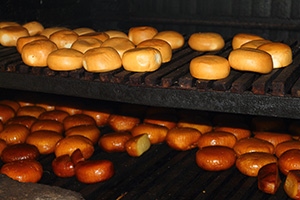 Smoked cheese and hardboiled eggs are good examples of adding taste to foods.
Smoked cheese and hardboiled eggs are good examples of adding taste to foods.
You can also smoke vegetables by laying them on racks inside your smoker. Smoked chilies and herbs can add unique flavors to stews or soups.
You can also smoke dried-fruits.
Smoking fish is one of the oldest and most time-honored traditions in all fishing societies.
Ever smoked jerky? Maybe it’s time to start experimenting.
Preservation
The preservative benefits from smoking derive from the fact that smoking helps inhibit bacterial growth. This is achieved in two ways.
Firstly is that the smoke creates a “coating” on the meat by binding and penetrating the outer layers. This kills bacteria and also inhibits further growth.
Secondly is that smoking can help to dehydrate meat. Bacteria and food spoiling organisms require moisture, and the dryer the substance, the fewer bacteria can grow.
Related: How To Use The Bark Of This Common Tree To Keep Your Meat From Spoiling
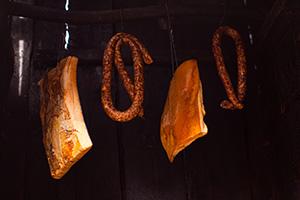
If your goal is long term preservation, you must cure your meats before smoking. Curing involves rubbing multiple layers of salts and sodium nitrite and sodium nitrate onto meats while allowing them to dehydrate.
Even after curing and smoking, make sure to store your food in dry, cool, and pest-free environments.
Food poisoning can originate from poor hygiene and contaminated animals or meat. Make sure that you only use cuts you can trust, and keep equipment and work surfaces sanitized. From slaughtering to eating, every step needs to be approached with diligence and the intent of maintaining food safety.
The Process
Hot Smoke
Hot smoking exposes meat to both heat and smoke. This should be done in a controlled environment where you can determine the heat and the amount of smoke.
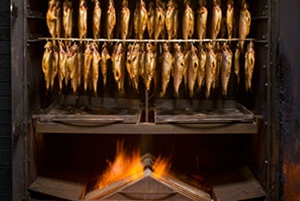
Hot smoking is done at temperatures ranging from 52 to 80 °C (126 to 176 °F).
You can smoke food items from 1 to 24 hours.
If the smoker goes above 85 °C (185 °F), your food could become completely dehydrated and inedible.
Most foods can be cooked again after hot smoking, but in many cases, like smoked hams, this won’t be necessary and you can immediately eat the foods.
Cold Smoke
Cold smoking is typically done at temperature ranges from 20 to 30 °C (68 to 86 °F). It is important to fully cure meats before cold smoking. Could smoking is also ideal for imparting flavor to nuts and cheeses.
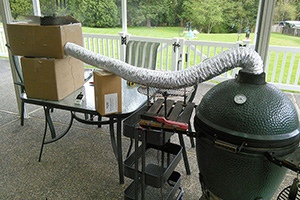
Ideally, you will cure your meat, like chicken, fish, or beef.
Then cold smoke for a while, and then do final cooking before eating.
Cold smoking is typically done for longer periods than hot smoking, and can sometimes go on for several days.
It’s important to be aware that cold smoking is not a substitute for cooking. Also, be aware that meat that has not been exposed to sufficient heat may harbor diseases and parasites still active deep in the flesh.
Be sure to stick to health guidelines concerning the cooking of meat to eradicate flesh borne parasites or bacteria.
Related: How to Build a Clay Pot Smoker
What Could Go Wrong
Curing
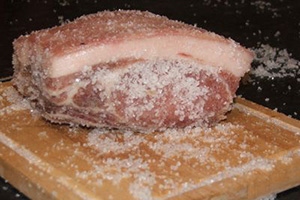 Too much curing can cause the meat to be too salty to enjoy. You could most likely still eat it in small amounts, but beware.
Too much curing can cause the meat to be too salty to enjoy. You could most likely still eat it in small amounts, but beware.
Too little curing will leave your meats susceptible to bacteria.
Many curing salts include sodium nitrate or sodium nitrite. These are important for preventing botulism, but should not be ingested above a certain threshold. Stick to health organizations’ guidelines on the matter.
Burning
Hot smoking can burn or severely scald your meats. Rather smoke cooler and longer, than hotter and faster. Burnt meat loses its nutritional value and carbonized/blackened portions are bad for your health.
Balance
Just as too much heat can burn meat, too little heat can leave meat raw. The cooking process doesn’t only change the nature of protein and fat but destroys bacteria and parasites.
What Wood To Use
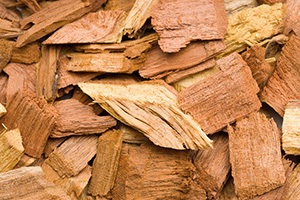 A simple rule is to use clean and dry hardwoods of species you know that won’t cause damage to your health or gut.
A simple rule is to use clean and dry hardwoods of species you know that won’t cause damage to your health or gut.
These can be used as smoldering logs or cut into shavings, moistened, and then placed onto coals to create smoke.
Hardwoods to use include Oak, Hickory, Maple, Pecan, Apple, Alder, Cherry, and Mesquite.
What Wood NOT To Use
Most softwoods like pine, or all needle producing tree’s, will give the meat a bitter taste. Never use chemically treated or painted woods, including wood that is moldy or rotting. Chemicals present in paints or treatments will end up on your meat and could be severely detrimental to your health.
Some types of wood contain compounds that can lead to severe diarrhea and even death. If you are not sure about the wood you have access to, don’t use it.
Species never to use include: pine, redwood, fir, spruce, cypress, or cedar.
More comprehensive lists are available, and you would be well advised to familiarize yourself with them.
When In Doubt
Smoking meat is not a technique for rescuing meat. Use only fresh cuts.
Meat from dead animals that may have been lying about for some time, or meat that may have started to spoil and have slimy layers of bad smells should not be smoked. In some cases, cold smoking may even make matters worse.
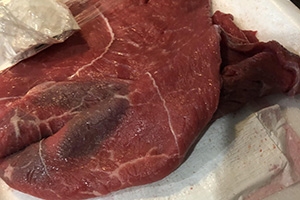 Before working with any meat, do a thorough inspection to make sure it’s safe.
Before working with any meat, do a thorough inspection to make sure it’s safe.
Look for any discoloration of flesh or fat, also look for signs of fluids leaking from the meat. Discolored water-like discharges or any slimy or viscous discharges could indicate unsuitability for human consumption.
Don’t ignore any strange smells coming from the meat of blood. Spoiled meat will also sometimes feel slimy or grainy.
There are a whole host of diseases and parasites that can be contracted from both living and dead animals. Organisms such as bacteria, parasites, and even viruses can infect humans when handling meat or through exposure to animal blood or other fluids.
Bacteria such as Salmonella, Escherichia coli (E. coli), Shigella, and Staphylococcus aureus (to name but a few) can be present in raw meat and animal blood. Clean working environments and thorough cooking will limit the risk of contracting diseases.
Parasites such as Tapeworm can be ingested from raw or undercooked meat.
Other diseases, though rare, can also affect humans. The list includes anthrax, cryptosporidiosis, dermatophilosis, Escherichia coli, giardiasis, leptospirosis, listeriosis, pseudocowpox, Q fever, rabies, ringworm, tuberculosis. Not all exposure results in clinical disease, and it’s also important to note that many diseases arise from exposure to milk, feces, or other bodily fluids.
You must follow hygiene protocols when working with meat to limit exposure and don’t eat meat if there are doubts about its safety.
Related: How To Smoke Bacon The Old-Fashioned Way
Source
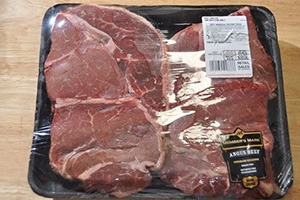 Despite regulations and their best intentions, abattoirs, butcheries, and even supermarkets supply thousands of pounds of contaminated meat to consumers every year.
Despite regulations and their best intentions, abattoirs, butcheries, and even supermarkets supply thousands of pounds of contaminated meat to consumers every year.
Most instances of food poisoning or illness from foodborne bacteria or parasites can be traced back to commercial slaughterhouses.
Most of the time it’s unintentional, but the human-error does occur.
It is important to source your meat from a trustworthy source. By slaughtering or hunting your meat, you will be in control of hygiene. Make sure that you know the signs and symptoms of the most common animal-borne diseases that can transfer to humans.
As a rule, only hunt and slaughter animals that look healthy, high spirited, and energetic. Lethargic, sloughing, or disoriented animals should always be avoided.
Great Taste
In almost all circumstances, smoking is a great way of creating delicious food while increasing food safety. It’s simple and effective and will create finger-licking meals with almost no spices required.
It does however require some practice, so the best time to start is now.
You may also like:
10 Things Cowboys Carried With Them in the Wild West to Survive (Video)
Lost Native American Survival Skills
Top 13 Prepping And Survival Items You Can Find At Farm Auctions

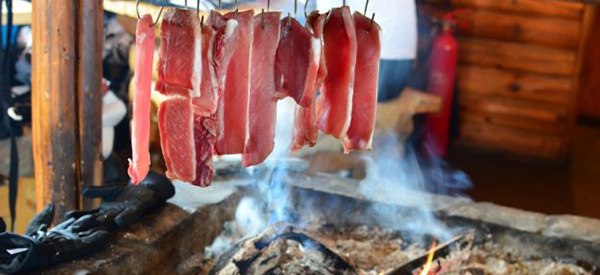














I don’t smoke my beat, I beat it.
Oh Lord, deliver us from fifth grade humor.
Proof reading before posting is never a bad idea.
good source for apple wood are the crab apple species that homeowners plant for decoration – find out they are pain when they mature and would welcome a $$$ & labor free removal …
Good hint, Illini, thanks for posting.
Hope ya’ll read this very carefully. you will need to learn this. very important info i cure my own meat. have had a slab of pork belly hanging in my prep room for 2 yrs now and still in perfect condition.
I salt cure and sugar cure pork only. no chicken and no beef only pork
I tried to salt cure some beef and it turned white. yes could still eat it, but.
so I use low heat to dry my beef.
once it is very dry i grind it up and place it in mason jars and vacuum seal it, label it and wait for the time I will need to use it.
yes it takes time, money and hard work. just like all the other thing in here…
I know you can just go buy some at the store so why do this or that.
that’s to much work
I might get burned
I might get cut trying to cut the meat up.
I don’t know how to start a fire.
okay. first thing is you can do this.
don’t let any one tell you that you can not do this or any thing else.
learn, learn, learn…
there will become a time. that there will be no stores open to just go buy what you want or need. this is all been giving to you on a golden plater, to learn all you will need to survive.
Thank you Claude, you have been giving us so much to help us in our journey in learning how to survive.
Just make sure you do this right. if not then it will get nasty for you very quick.
Once you learn how to do this you will have a peace of mind knowing that you have fresh and naturel meat, no preservative, unless you buy it in the store. Find a local butcher, He’ll be your best bet.
be careful buying from the stores some meat that i have bought is old meat not rotten but smelled old and tasted old. Lost some good money on that mistake. local butcher, if you don’t have one then learn how to butcher your own. there is an article on that in here. I bet…
Good luck out there in the new Babylon
Well said! You are awesome to be so specific and detailed in your advice! I can’t tell you how I appreciate this. I’m a single mom of young adults and feel the burning need to be “prepared”, wholeheartedly. My whole family except my mom are in denial and I’m glad to show them bits of valuable advice from caring people like you. Thank you so very much again! Anita
Ani.
You keep on doing what your heart tells you. That is a sign from GOD. Telling you to get ready.
Don’t let anyone tell you that it is stupid to do this.
I caught a lot of hell from every one about me saying you need to be prepared for yrs and yrs, even almost costed me my marriage. she is on bored now. I guess she should be, been hearing me for 32 yrs now. lol
The one thing that will stop you from prepping or learning something is {YOU…}
There are really good people on here that will help you in any way they can. So keep on prepping and listen to your heart.
I will tell you the reason I call my self RED ANT, is because they will survive anything that comes at them and they harvest and prep for the seasons. I have been watching them for over 50 yrs now and they will tell you if its going to get cold or if its going to rain. My wife thinks I’m nuts, till she saw that I was right about some things that happed with the weather. I will not buy a place to live unless it has a red ant bead on it. Yes were I live has a bead on it know and I do feed them and take very good care of them also. They in return clean my yard of pest and unwanted things that they don’t like. I love to watch them in action. so funny I know…
I don’t know why I told you that but there it is.
If you need any info, please fill free to ask any one of us. We are here for you. Yes, I might be a little harsh but you will understand.
Good luck with you prepping… Open your heart and let GOD show you what to do. And Think you also…
God usually gives people that burning desire. Just like being called to the priesthood. He calls some to prepare, some to arm themselves, and still others to teach. Get rid of all your earthly goods. (Your kids probably won’t want them anyway.) And buy provisions, items to trade. Even if you don’t have a gun (which is NOT a good idea), ammo will be very valuable. Thanks Claude. Blessings to all you preppers.
Not so sure I’d use “ old steel oil drums”. Just saying.
KDC: burn them out, them wash with hot soapy water. Scrub down with ammonia and rince. If nothing else, you can always use them to store sacks of grain and beans in. niio
Another way of drying meat is to rub it with the salts and sugar then hang it in the attic in the summer time. It is hot enough in most attics that over time it will dry the meat very good. As a side point you can build a screened box to hold the meat in which will protect it from any insects or rodents when it is drying. This takes very little effort and works really well.
I saw a show where they made a foil lined box and hung it outside the window of their house. Facing the sun of course. I guess if you use smaller pieces and the temp stays up, that’ll work!
Nice article. It gives a ‘basic’ understanding of the process. Before anyone decides to cure and smoke their meat, read up on how it ‘should’ be done and speak with a few butchers or others who have done this for awhile. While the overall process is the same, certain meats require a slightly different process than other meats for curing and smoking. I’ve seen and eaten some meats that were cured and smoked at least ten years before I tried it. I’ve also purchased some smoked meat that literally was green in the center,(If I remember right, it was a ham) and had a terrible odor to it. Remember, anytime you decide to ‘preserve’ food…it’s on you to do it right. Your health and the health of your family is dependent on that. Good point, in the article, about not hunting or slaughtering animals that appear unhealthy or slightly ‘off’ from how they ‘should’ be acting.
Good article on a favorite subject! Gotta be mesquite. Here, it’s the favorite if only because you get busted cutting someone oaks or pom fruitwood, you’ll find out what rock salt feels like when driven into the skin. Next best favored is damp corncobs. For German bacon and so on, a little spruce (no needles!) adds to the flavor. Yew and a lot of woods are toxic or taint the meat. niio
Why not cedar? We’ve used cedar, many times, for salmon, without problems.
For some reason unknown to me, cedar seems to go fine with salmon but not quite so fine with red meat. It may well be that it is an individual taste thing. There may be some scientific reason behind it. I am fairly certain SeaBear Salmon Company sells cedar planks to barbecue your fresh salmon on.
You now have received all the information I have in my data banks regarding using cedar wood when barbecuing or smoking. Wait! Wait! My memory reader is getting a faint impression of data regarding cedar smoked salmon but the info apparently has been written over a time or two and so is not able to be completely recovered.
Sorry I couldn’t be more informative. If I feel especially motivated tomorrow I might go on line to SeaBear’s website and see if they do indeed sell cedar planks for salmon barbecuing. Stay turned for further developments.
I went to Sea Bear’s website and I was wrong, wrong, wrong. The cedar planks that I thought they were selling turn out to be Sapele wood – Characteristics and Uses of Sapele Wood
http://www.woodassistant.com/wood-database/sapele:
Sapele (also known also as aboudikro, saplewood, sapelli and Sapele Mahogany) is one of the largest trees that are native to the regions of tropical Africa. As a part of the genus Entandrophragma and the family of Meliaceae, it can be commonly found in rainforests of Ivory Coast, Ghana, Nigeria, Cameroon, Uganda, Tanzania, and others.
And I gather from the text accompanying the wood that it is for serving the fish on, not for cooking the fish on. Apparently the faint response I was getting from my memory banks had been written over too many times to be a little more definitive. I had never heard of sapele wood, so included a definition of it for those who were of a similar state of mind as I.
wolf: As I understand, it contains turpin which block absorption of protein. It’s a good flavoring but not too much. Aside from that, most don’t have access to it. I can use mesquite, some oak, and corncobs. niio
LOL! No access to cedar? I can’t comprehend that. In the Midwest/High plains states cedar is taking over rangeland like Brome grass took over the road ditches.
Spike: You’re welcome to go to any place in the southwest and show me a cedar tree. You’re talking juniper, which is a relative, but not cedar. The only cedar I ever saw were in kali and the northeast, as well as cemeteries. Juniper is not used for cooking because of terpin and other things.
Red: You have been missing out, apparently.
The berries turn vodka into gin.
I copied this from a cooking website:
Some common uses and healing properties of juniper:
It can be made into a cleansing tea used twice per day.
It has been found to make excellent poultices for wounds and promotes healing.
Juniper berries increase urine production and are used to treat urinary infections.
Anti-inflammatory properties make it a prescribed treatment for arthritis.
The berries are said to fight off or eliminate herpes virus flares.
It was used as a treatment long ago for syphilis and gonorrhea.
It’s said to decrease upset stomach and heartburn.
The juniper berry lessens bloating and increases appetite.
Juniper berries are most famous for their use in gin.
It can be used as a spice—a little goes a very long way.
It’s a great adjunct to meat dishes such as beef, pork, or wild game such as venison.
Scandinavians, Northern Italians, and Germans use juniper berries in many dishes.
The berries add delicious flavor to vegetable dishes and things like sauerkraut.
It can be used to make soaps and skin oils.
It’s said to be beneficial in treating skin conditions such as acne and psoriasis.
It can be used in fragrances and sachets for its clean, pine-like scent.
Who knew? What started my search was I vaguely remembered eating roast pork with juniper berries from long, long ago and far, far away – Pennsylvania to be more specific. I think the strong flavor of the juniper berries would preclude using them as a condiment with fish. I don’t know. Fish and capers — fish and juniper berries???
LCC: that’s the berries. Remember, you can eat elderberries, too, but the leaves are toxic as is the wood. the family hasn’t had a whole lot of use for juniper berries since Prohibition ended. 🙂
niio
Though juniper berries make a yummy sauce for your ribeye!!
Cindy: We haven’t had a lot of use for juniper berries since prohibition ended. 🙂 I’m of Arizona, but lived for a long, very long time in Eastern PA. Eastern berries are a lot milder than Arizona. Yeah, eatable, but it’s recommend women who are or want to be pregnant not eat anything from conifers. While it’s pretty unlikely I’ll ever get pregnant (I’m over 60 and male LOL) I do not recommend using many in anything. Ditto spruce, tho I like new shoots. Some spruce tree shoots trast like terpin, but very often like strawberries. In the old days, the only folks under 40 who were allowed alcohol were women of childbearing age. I have no clue where Penn State got the idea American Indians didn’t drink adult beverages because the goofs are always finding wax-sealed pots that have the remains of juice and fermented corn (for beer) in them. Some of my neighbors are Mescalero, and they taught the Spanish how to make mescal. Hope the nor’easters (the rest of them) miss you. niio
red ant: Just mind those horned toads. Red ants are their favorite food 🙂 You can walk all over red ants and they’ll usually leave you along. bug one, one too many times and you’ll be in agony for a long, long time. niio
Red
There are no more horned toads left around here any more, just red ant beds. All the pest control killed most of them. Out in some of the areas they are still there, but not many.
Sad, I remember when I was a kid they were every were. The red ant beds are still pleniful. But again man has to screw it up for every thing.
LCC: and the smells 🙂 niio
Well, I cut branches off the juniper tree that the neighbor has growing mostly in my yard because I am south of the tree for Christmas because I like the smell of fresh juniper. May be that my olfactory glands are defective but it smells like other evergreens inside the house.
LCC: we have a pine in the yard, planted when the town went in, 1953. Now that smells great even in summer. It can be a pest, stealing all moisture from some garden beds and blocking the morning sun in winter, but looks good, and the shade is great in summer. Juniper? good in winter, but a major fire hazard all year long. niio
Red,
Not too bad a hazard as long as forestry service ain’t trying to burn it down or it gets hit by lightning, lol. I like the berries, eaten by themselves they have beneficial properties. Slightly bitter though as most medicine is.
Hawthorn: Arid area junipers make a flammable gas when stressed by drought. the tree doesn’t mind getting burned off, it sprouts from the roots. That clears off all the mulch trees like madrone need for it’s first few years. The seeds do best in barren soil, so fire is a win-win. niio